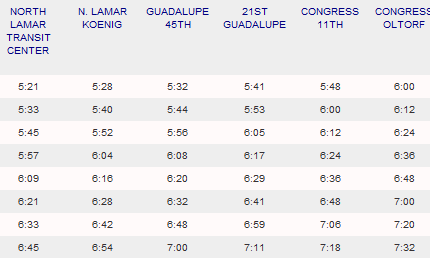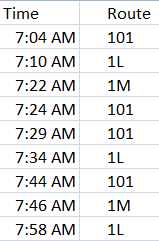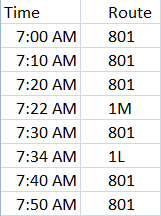So it turns out I’m so busy now I can’t even keep up on twitter most days – but this deserved a momentary break.
People, salve and by that I mean Capital Metro and their cheerleaders, assured us that the Red Line would be “as good as light rail” once it ran all day. Instead, we have one or two ‘full’ trips per day and a lot of empty ones. And the full trips are misleading – express bus competitors were cancelled, a ton of free passes were given out, and a peak trip was dropped (IIRC), concentrating slightly more people on slightly fewer trains.
Well, anyways, it’s running all day now – and yet is achieving 1700 boardings per day compared to the 25-30K mediocre light rail lines that run all day are pulling (and that the 2000 light rail route would easily have pulled).
It’s time to ask again: WHY? Why are the tens of thousands of people within walking distance of the 2000 route who Capital Metro assured us would ride shuttlebuses not riding?
Well, wonder no more.
Alon Levy of Pedestrian Observations forwarded me this study with this short summary (summary from him):
@mdahmus tl;dr version: commuters don’t mind transfers at the outer end, but hate transfers in the CBD.
So there you have it. Too bad Capital Metro and cheerleaders not only didn’t listen in 2004, but still won’t listen – not even today. Yes, even now, I’m having to fight this battle in the comments section of their very own blog.
So, in summary, it’s important to remember: lots of people don’t mind taking a bus from their house to the train station, but almost everybody minds taking a bus from the train station to their office. Never forget.
Background, mostly from yours truly over the years:
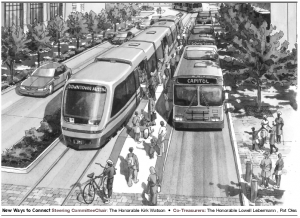
2006: Capital Metro still brags that  “Regular and special shuttle buses will whisk you to your final destination.” – I don’t buy it.
2008: Christof Spieler writes that “Passengers don’t want to transfer to a circulator service to get to work, even a high-quality circulator like Denver’s“ (link within post by me)
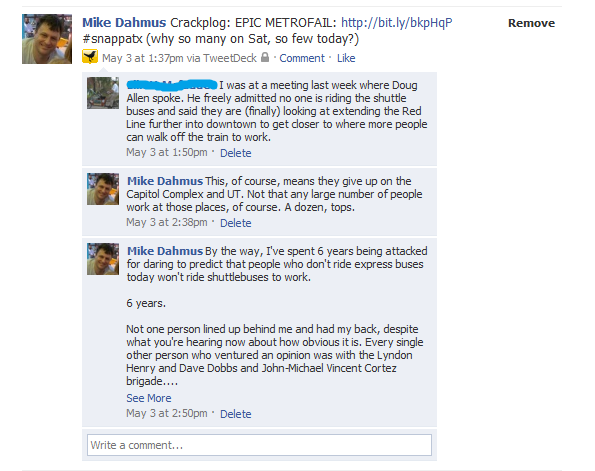
- 2010 if I remember correctly.
Please excuse the quick and multiple likely edits. Trying to squeeze this in just a few minutes.
The PR guys at Capital Metro have surfaced again – trying to convince us that MetroRapid is a real improvement for Central Austin (you know, cure where light rail should have gone). One of the claims gaining traction lately (in addition to the disproved claim that it will provide measurable speed and reliability benefits – please excuse link to old site but I have not yet imported the last 6 months of posts here) is that frequency in the core will improve dramatically.
Pure and simple: This is bullshit.
Current service on the #1 bus during the day is every 12 minutes (once you leave the core, disease very generously defined as the North Lamar Transit Center to the South Lamar Transit Center, symptoms it splits into 2 routes, each one of which runs every 24 minutes).
Full #1 schedule here:Â http://www.capmetro.org/riding/schedules.asp?f1=001
Here’s a snippet:
Note that the #1 runs every 12 minutes here. This continues all day until 2:45 PM, when it switches to every 13 minutes (due to worse traffic in the PM); only reducing frequency below that after 7:15 or so – gradually to 15 minutes and then 20 minutes.
Now what about the #101, you know, the bus route that the Rapid [sic] Bus is actually replacing?
Full schedule here:Â http://www.capmetro.org/riding/schedules.asp?f1=101
Here’s a snippet:
A little tricker since only some of the trips go all the way to the South Congress TC, but it does run at 15 minute frequency basically all day long.
What does this mean? It means that in an average hour, if you are on the #1 corridor anywhere in Central Austin, you will see 5 #1 buses and 4 #101 buses go by. For instance, this is what you would see southbound between 7:00 and 8:00 AM at The Triangle, where you can pick up either bus:
From Capital Metro’s interactive data:
101: 07:04am 07:24am 07:29am 07:44am
1L:Â 07:10am 07:34am 07:58am
1M:Â 07:22am 07:46am
Or, arranged in order:
Now here’s what frequency might look like with Rapid [sic] Bus if we run the 801 every 10 minutes and eliminate, let’s say, half of the #1 trips (Capital Metro is saying all #101 and some #1 trips will be eliminated):
Does anybody here think 8 is more than 9? Or, if you don’t like which 1L/1M trips I proposed for elimination, make your own choice – keep the first and third 1L and lose the second one; and keep the opposite 1Ms, and you still end up with 9. Oops.
Even if you kept all the #1 trips (i.e. did NOT take Capital Metro at their word that they plan on reducing #1 service), and you end up with 11 trips versus 9 – hardly a major improvement in frequency.
Now, will the service improve frequency for users of the #3? Yes, a little bit, but this is not the primary corridor being advertised – nor is it where most of the current travel demand exists.
So, on this fact check, Capital Metro fails. MetroRapid will NOT dramatically increase frequency in the urban core.
PS: This is the kind of analysis you should expect out of the Alliance for Public Transportation – who purports to be an independent voice for public transportation in our region but are really nothing but uncritical cheerleading lap-dogs for Capital Metro. I have the guts but not the time; they have the time but apparently not the guts. If you want more of this kind of stuff, ask THEM why they’re not doing their jobs, OK?
